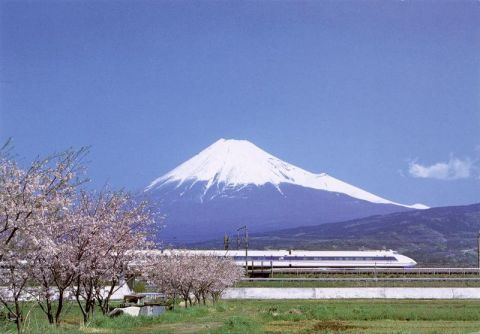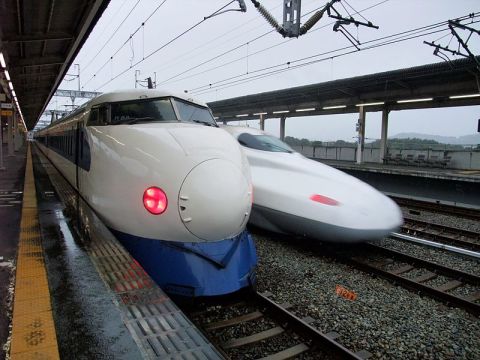An interesting look at how the Japanese Shinkansen system has literally shaped Japan’s urban development pattern:
At 10am on 1 October 1964, with less than a week and a half to go before the start of the Tokyo Olympic Games, the two inaugural Hikari Super Express Shinkansen, or “bullet trains,” arrived at their destinations, Tokyo and Osaka. They were precisely on time. Hundreds of people had waited overnight in each terminal to witness this historic event, which, like the Olympics, heralded not just Japan’s recovery from the destruction of the second world war, but the beginning of what would be Japan’s stratospheric rise as an economic superpower. The journey between Japan’s two biggest cities by train had previously taken close to seven hours. The Shinkansen had made the trip in four.The world’s first high-speed commercial train line, which celebrates its 50th anniversary on Wednesday, was built along the Tokaido, one of the five routes that connected the Japanese hinterland to Edo, the city that in the mid-1800s became Tokyo. Though train lines crisscrossed the country, they were inadequate to postwar Japan’s newborn ambitions. The term “shinkansen” literally means “new trunk line”: symbolically, it lay at the very centre of the huge reconstruction effort. All previous railways were designed to serve regions. The purpose of the Tokaido Shinkansen, true to its name, was to bring people to the capital.
[…]
In an interview in the Tokyo Shimbun newspaper last week, Takashi Hara, a political scholar and expert on Japanese railroads, said the policy of extending the Shinkansen was promulgated by Kakuei Tanaka, Japan’s prime minister from 1972 to 1974. “The purpose was to connect regional areas to Tokyo,” Hara said. “And that led to the current situation of a national Shinkansen network, which completely changed the face of Japan. Travel times were shortened and vibration was alleviated, making it possible for more convenient business and pleasure trips, but I have to say that the project just made all the [connecting] cities part of Tokyo.”
And where the Shinkansen’s long tentacles go, other services shrivel. Local governments in Japan rely heavily on the central government for funds and public works — it’s how the central government keeps them in line. Politicians actively court high-speed railways since they believe they attract money, jobs and tourists. In the early 1990s, a new Shinkansen was built to connect Tokyo to Nagano, host of the 1998 Winter Olympics. The train ran along a similar route as the Shinetsu Honsen, one of the most romanticised railroads in Japan, beloved of train buffs the world over for its amazing scenery – but also considered redundant by operators JR East because, as with almost all rural train lines in Japan, it lost money. There were only two profitable stations on the line — Nagano and the resort community of Karuizawa — and both would be served by the new Shinkansen. A large portion of the Shinetsu Honsen closed down; local residents who relied on it had to use cars or buses.
Meanwhile, the bullet train has sucked the country’s workforce into Tokyo, rendering an increasingly huge part of the country little more than a bedroom community for the capital. One reason for this is a quirk of Japan’s famously paternalistic corporations: namely, employers pay their workers’ commuting costs. Tax authorities don’t consider it income if it’s less than ¥100,000 a month — so Shinkansen commutes of up to two hours don’t sound so bad. New housing subdivisions filled with Tokyo salarymen subsequently sprang up along the Nagano Shinkansen route and established Shinkansen lines, bringing more people from further away into the capital.The Shinkansen’s focus on Tokyo, and the subsequent emphasis on profitability over service, has also accelerated flight from the countryside. It’s often easier to get from a regional capital to Tokyo than to the nearest neighbouring city. Except for sections of the Tohoku Shinkansen, which serves northeastern Japan, local train lines don’t always accommodate Shinkansen rolling stock, so there are often no direct transfer points between local lines and Shinkansen lines. The Tokaido Shinkansen alone now operates 323 trains a day, taking 140 million fares a year, dwarfing local lines. This has had a crucial effect on the physical shape of the city. As a result of this funnelling, Tokyo is becoming even denser and more vertical — not just upward, but downward. With more Shinkansen passengers coming into the capital, JR East has to dig ever deeper under Tokyo Station to create more platforms.





